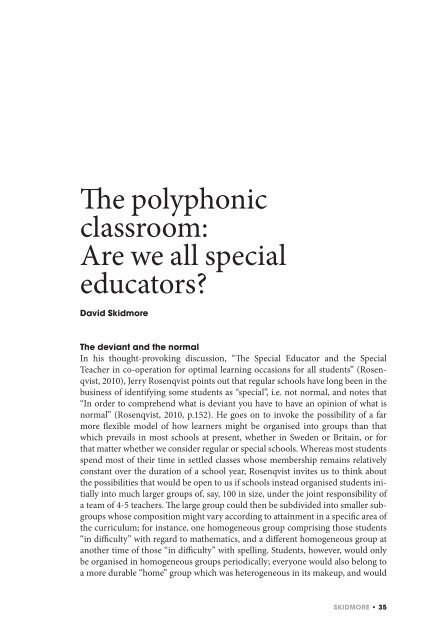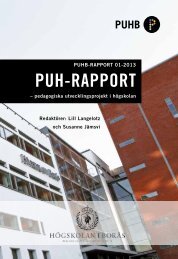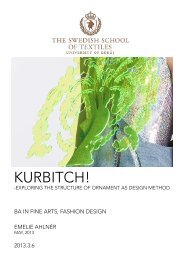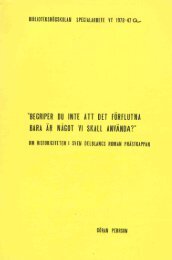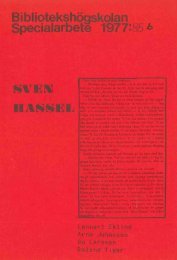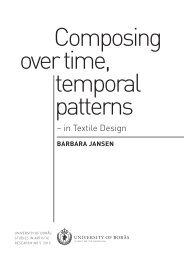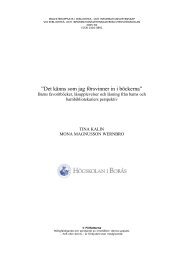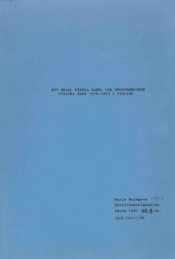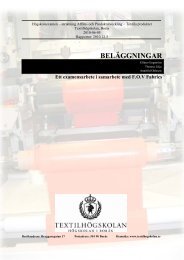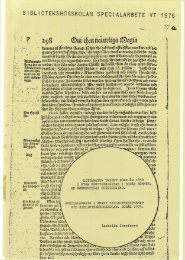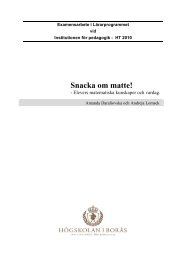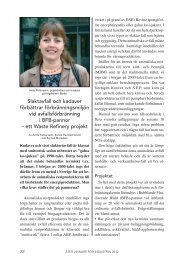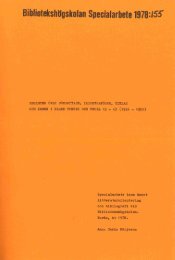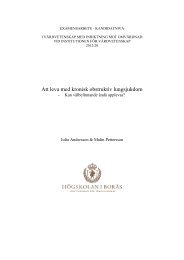- Page 1 and 2: Bildning för alla! En pedagogisk u
- Page 3 and 4: © Högskolan Kristianstad och resp
- Page 6 and 7: Innehåll Förord 6 Bildning för a
- Page 8 and 9: Bildning för alla! En bok tillägn
- Page 10 and 11: författarpresentation Allan, Julie
- Page 12 and 13: lang, lena Fil. dr, universitetslek
- Page 14: Östlund, Daniel Doktorand i pedago
- Page 18 and 19: Bildbar - men inte anställningsbar
- Page 20 and 21: mellan länders utbildningssystem o
- Page 22 and 23: fram en möjlig väg där den verti
- Page 24 and 25: Vägar framåt I ett pressmeddeland
- Page 26: Official Journal of the European Co
- Page 29 and 30: (1990) deklaration framhåller Jarv
- Page 31 and 32: cipen om öppenhet betyder att det
- Page 33 and 34: ner, såväl som i fortlöpande ana
- Page 35: Svensson, A.-K. (2011). Lärarstude
- Page 39 and 40: Now what I want is, Facts. Teach th
- Page 41 and 42: that lies at the heart of all human
- Page 43 and 44: willed away. The pre-existing notio
- Page 45 and 46: tances, and both of which I was tau
- Page 47 and 48: Konventionsstaterna skall säkerst
- Page 49 and 50: mas och eventuellt kan en pedagogis
- Page 51 and 52: Detta skedde alltså trots att det
- Page 53 and 54: Goffman, E. (1973). The presentatio
- Page 55 and 56: Metaanalyser - en dominerende trend
- Page 57 and 58: Forskerholdet udvalgte 26 undersøg
- Page 59 and 60: ling tager udgangspunkt i at vælge
- Page 61 and 62: det sig lige modsat. Karpatschof (i
- Page 63 and 64: To illustrative eksempler Modellen
- Page 65 and 66: serne mellem kvantitative og kvalit
- Page 67 and 68: En spørgeskemaundersøgelse til et
- Page 69 and 70: Danish Clearinghouse for Educationa
- Page 72: Internationella perspektiv på spec
- Page 75 and 76: Stigningen i andelen af elever i sp
- Page 77 and 78: specialklasser eller specialskoler,
- Page 79 and 80: sociale eller faglige kundskaber og
- Page 81 and 82: satser. Denne antagelse begrundes m
- Page 83 and 84: læring samt elevindflydelse, at el
- Page 86 and 87:
Har vi ein skule for alle? Peder ha
- Page 88 and 89:
har vi ein inkluderande skule? Det
- Page 90 and 91:
som kontrollerer elevane sine aktiv
- Page 92 and 93:
Drøfting At ein vesentleg del av e
- Page 94 and 95:
kan fungere godt, avhengig av ei me
- Page 96 and 97:
Den svårfångade inkluderingen: ex
- Page 98 and 99:
optimal kunskapsutveckling och soci
- Page 100 and 101:
De nationella utbildningspolitiska
- Page 102 and 103:
Detta antas ha betydelse för hur s
- Page 104 and 105:
i sammanhanget, det psykologiskt-me
- Page 106 and 107:
på dilemmat blir olika i olika sko
- Page 108 and 109:
Emanuelsson, I., Persson, B. & Rose
- Page 110 and 111:
The inclusion challenge Julie Allan
- Page 112 and 113:
any child from being part of this e
- Page 114 and 115:
Pijl and Frissen (2009), casting a
- Page 116 and 117:
On a wider scale, The World Report
- Page 118 and 119:
and problems associated with provis
- Page 120 and 121:
Meijer, C. (2003) (ed.). Inclusive
- Page 122:
Särskolans pedagogik och elever Bi
- Page 125 and 126:
personkrets, eftersom de inte anset
- Page 127 and 128:
deras grannar. Personalens bemötan
- Page 129 and 130:
EOV som enbart förekommer på Inte
- Page 131 and 132:
ner med lindriga intellektuella fun
- Page 133 and 134:
• Forskning som kan bidra till ö
- Page 136 and 137:
Särskolan i ljuset av FN-konventio
- Page 138 and 139:
encounter many disadvantages in the
- Page 140 and 141:
inledningen av denna text, har gymn
- Page 142 and 143:
det naturligtvis an på personen vi
- Page 144 and 145:
funktionsnedsättning, uppfattar oc
- Page 146 and 147:
Om speciallärare med inriktning ut
- Page 148 and 149:
Schweiz och Johan Kellers skola fö
- Page 150 and 151:
erna ett yrke som efter avslutad sk
- Page 152 and 153:
och den mot utvecklingsstörning. I
- Page 154 and 155:
het att utveckla och därmed kvalif
- Page 156 and 157:
förstås i förhållande till hur
- Page 158 and 159:
SFS 1944:477. Lagen om obligatorisk
- Page 160:
Integrering och inkludering BilDnin
- Page 163 and 164:
One which was travelled by children
- Page 165 and 166:
Inclusion and educational processes
- Page 167 and 168:
the municipalities. They conclude t
- Page 169 and 170:
On a general level there seems to b
- Page 171 and 172:
From a different angle it is quite
- Page 173 and 174:
Eriksson, L. & Granlund, M. (2004).
- Page 175 and 176:
SOU 1997:121. Skolfrågor - Om en s
- Page 177 and 178:
vara nyttig och mitt bidrag skulle
- Page 179 and 180:
former (Darling-Hammond & Bransford
- Page 181 and 182:
eleverna ganska släta då detta do
- Page 183 and 184:
giska minnet är tyvärr kort hos v
- Page 185 and 186:
Hjörne, E. & Säljö, R. (2008). A
- Page 187 and 188:
svepa över alla skolformer och fra
- Page 189 and 190:
2006; Hjörne & Säljö, 2008; Lund
- Page 191 and 192:
S Dels har vi ingen skyldighet att
- Page 193 and 194:
ningsvis undertecknas av berörda p
- Page 195 and 196:
göras över insatser av träningsk
- Page 198 and 199:
Inkluderande verksamheter Möjlighe
- Page 200 and 201:
faktorer som står i förgrunden oc
- Page 202 and 203:
till att underlätta barnets läran
- Page 204 and 205:
det i vuxnas andraspråksinlärning
- Page 206 and 207:
Mara Westling Allodi (2010) har i e
- Page 208 and 209:
Dessa är lärares förhållningss
- Page 210 and 211:
Slutsatser I detta kapitel har sams
- Page 212:
Lahtinen, U. (2011). Goda läsresul
- Page 215 and 216:
iske forskningsprojekter i denne pe
- Page 217 and 218:
ker, der gør en forskel - og som k
- Page 219 and 220:
de samme materialer som de andre el
- Page 221 and 222:
hverdag. For at vende denne udvikli
- Page 224 and 225:
Inkludering i svensk lärarutbildni
- Page 226 and 227:
detta sätt att förstå inkluderin
- Page 228 and 229:
pedagogiskt stöd vilket ofta nämn
- Page 230 and 231:
inkluderingsperspektivet vid högsk
- Page 232 and 233:
grundskolan. Dessa åtgärder syfta
- Page 234:
Epilog ingeMAr eMAnUelSSOn • 233
- Page 237 and 238:
lingsperspektiv. Det nog så tydlig
- Page 239 and 240:
skilda skolformen, visar klara samb
- Page 241 and 242:
i stället för att behandlas som s
- Page 244 and 245:
Jerry Rosenqvist Christer Ohlin Jer
- Page 246 and 247:
Rosenqvist, J. (1985). Undervisning
- Page 248:
Rosenqvist, J. (2007). Några aktue


